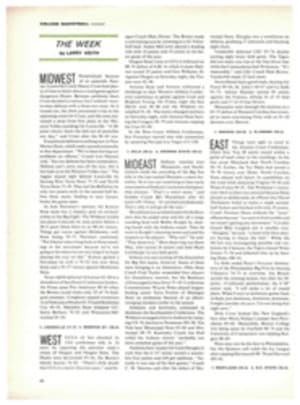
Pips for the bats of China
Two years ago in Yugoslavia, at the last World Table Tennis Championships, a time-honored Chinese custom was abruptly ended: Peking's players neglected to win the sport's two main prizes. The Swaythling Cup for men's team play was carried home by Swedes, while its counterpart for women, the Corbillon Cup, was lugged to South Korea.
Though Peking's trophy chest did not go empty—the Chinese won the men's and women's singles cups—experts thought they saw a trend. Tamed to house pets by too many "friendship" visits, China's tigers had been caught, perhaps passed. In particular, Europe's men were cited: Sweden's wily Stellan Bengtsson and his forehand-slugging teammate, Kjell Johansson; Yugoslavia's Dragutin Surbek and Anton Stipancic, representing a new breed of crushing topspin artists; that fiercest spinner of them all, Hungary's Istvan Jonyer—players whose smooth-faced sponge rackets, long bowler's backswings and longer, upward-whipping strokes can loop the ball so savagely that it will carom off an unprepared opponent's paddle and go straight up, 10 feet or more.
Last week, reportedly in good form, all of Europe's finest were among the players from 53 countries who gathered in Calcutta for the 33rd world championships, and the question being asked was whether a European team could once again keep the cup away from China. Her strength was hard to read. In recent matches throughout the world China's record had been good, but it was often difficult to tell if her table-tennis ambassadors were really trying. China has so many players it was hard to figure which would be selected for the Swaythling Cup team, and after the five were announced who could say which styles would be relied on?
Since style is important in Swaythling Cup play, captains try to make choices that are best against particular opponents. They must guess which players will be used against them and their order of play—facts revealed only in the sealed lineups both sides hand in just before the matches.
Of the 10 men China brought to Calcutta (three would play in the singles and doubles only, not the cup matches), all were probably sound Swaythling Cuppers. Moreover, they represented all styles: European-type loopers, defenders (nearly extinct, these days) and even classic Chinese penholder-grip attackers with blocking backhands and compact, rapid-fire forehands (very rare also).
In Calcutta's 12,500-seat Netaji Stadium, newly built for the event, it was easy to spot the Chinese. As always, they moved in large groups, and in their red track suits they were either a vivid cluster in the stands or a long red line moving around the perimeter of the vast wooden playing floor, where 20 tables were centered in green-barriered rectangles 46 by 23 feet. One fact stood out as brightly as the outfits: China had not named to her Swaythling team the reigning world singles champion, Hsi En-ting. "Not good enough," said Hsu Yinsheng, head of the Chinese contingent. "But we brought him along so he could defend his singles title." So the world champion obediently followed the red processional, but he played in the practice hall only during team competition.
Not good enough? Perhaps. But a better guess, as events soon demonstrated, was that China, having lost the team cup ("More important than the singles cup," said Mr. Hsu), was abandoning the modern style as represented by Hsi En-ting and returning to the classic.
A decade ago, when no one dreamed of beating China, her world singles champion was Chuang Tse-tung. He was the sport's alltime greatest and he regularly displayed the clean, destructive force of the classic Chinese game. Integral to this style is the simple pip-faced sponge bat, far slower and less grippy than the smooth-faced inverted-pips sponge used today by almost every world-class player. Pips-out sponge is easier to use in some ways than the flat surface but much harder in other ways. There is more control, but you don't make any cheap points with it because you can't play spin-ball with the spinners, and you can't make the ball do the tricks it will do off the inverted pips. But Chuang was not a spinner or a trickster. He believed in power. Mechanically perfect, his piston forehand rifled balls on a low, flat trajectory to the smallest targets on the table. It was a short, cruel stroke, a kind of upward karate slice toward his forehead. Watching him, one always felt surprised if a shot he had tried, no matter how daring, missed. He was an artist, and he had the habit of perfection.
Chuang's style supposedly is dead; the hypermoderns claim that even at his best Chuang could not have attacked today's loopers, and Chuang, who retired in '71, is not around to prove them wrong. But perhaps he has been training surrogates. Certainly the play at Calcutta suggested it, for in China's first difficult match, against Yugoslavia, a team led by the dreaded spin merchants Surbek and Stipancic, China sent out a team of attackers all reminiscent of Chuang, and they all used pips-out sponge. In the warm-ups their bats seemed inadequate against the menacing Yugoslavs, but when play began, what destruction! The rat-tat-tats of their forehands were heard all over the hall, and the source was unmistakable because the flat sponge, being used on all other tables, is nearly silent. In particular, Hsu Shao-fa and Li Chen-shih did the damage. They cut up Surbek and Stipancic like a team of hurried surgeons on amputation duty. One admired their skill and was awed by the outcome.
Next China played Hungary, and this time Peking sent in not three but 2½ pips-out players—surgeons Hsu Shao-fa and Li Chen-shih and now a third, Liang Koliang, a small, wiry acrobat who plays half-and-half, pips in on one side of his bat and pips out on the other. With his half-and-half, Liang wholly destroyed two Hungarians, Gabor Gergely and Janos Borzse, 21-10, 21-8 and 21-8, 21-8. The final result was China 5-0.
After honing their scalpels on Japan (5-3), the Chinese went to work on Sweden. This, although a semifinal, was supposed to be the big match, and the Swedes were given a good chance. But only the 6'3" Johansson, nicknamed The Hammer, came through. He made comebacks against Liang and Li and won both of those matches, but Bengtsson lost the three he played, and Ulf Thorsell, the third Swede, did not have a prayer in his two.
That brought things to the finals where, curiously, the undefeated Chinese again saw Yugoslavs coming to the table, grim but ambulatory—a team left for dead in the operating room. But there was no mistake: China and Yugoslavia had finished first and second in their group, then Yugoslavia had beaten Czechoslovakia, the top-finishing team in Group A, and so moved into the finals.
Surbek, 28, is not the most graceful of players; the Yugoslav is often forced out of attacking position and on to defense. But he has a shot for this. Retreating to the barrier, some 18 feet behind the table, he returns his opponents' kill shots with high arcing lobs that soar about 20 feet above the net and are not easy to put away because of the topspin they carry. In the finals against Hsu, Surbek often made half a dozen successive lobs, and if Hsu weakened on any kill Surbek would lunge at the ball with a savage forehand counterdrive, hurtling his entire body at it, usually ending up on the floor with the point won or lost above him.
Hsu was quite a different player. To appreciate Hsu one must understand form and the beauty of mathematics, or, as one Dutch player put it, "the concept of space and time." Hsu's most interesting trait is a serve in which he throws the ball 15 feet straight up. The increased velocity of the ball, falling from that height, gives Hsu more mass to deal with at impact, thus more spin.
Hsu was undefeated when he met Surbek the second time around, and Surbek had lost only once, to Hsu. This time Surbek evened their personal record with a stunning comeback win, 21-23, 21-16, 21-14, but China won, five matches to three, and therefore the cup.
Afterward Chinese players went back to the practice room to warm up for the singles. A Hong Kong player passing through heard one Chinese say to another, "I am getting tired, let's quit. Last 50 games."

